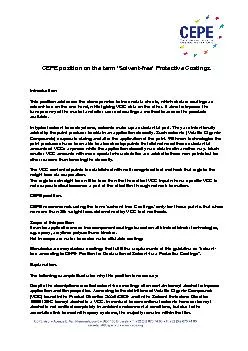

free Protective Coatings Introduction This position addresses the discrepancies between data sheets which declare coatings as solvent free on the one hand whilst giving VOC data on the oth ID: 854984
Download Pdf The PPT/PDF document "CEPE position on the term Solvent" is the property of its rightful owner. Permission is granted to download and print the materials on this web site for personal, non-commercial use only, and to display it on your personal computer provided you do not modify the materials and that you retain all copyright notices contained in the materials. By downloading content from our website, you accept the terms of this agreement.
1 CEPE position on the term âSolvent - f
CEPE position on the term âSolvent - freeâ Protective Coatings. Introduction. This position addresses the discrepancies between data sheets, which declare coatings as solvent - free on the one hand, whilst giving VOC data on the other. It aims to improve the transparency of the market and offer users of coatings a method to assess the products available. In typical solvent based systems, solvents make up a substantial part. They are intentionally added by the paint producer to obtain an application viscos ity. Such solvents (Volatile Organic Compounds) evaporate during and after the application of the paint. With new technologies the paint producers have been able to also develop paints that did not need these substantial amounts of VOCs anymore while the a pplication viscosity was obtained in another way. Much smaller VOC amounts with more special characteristics are added to these new paints but for other reasons than lowering the viscosity. The VOC content of paints is established with well recognized te st methods that register the weight loss via evaporation. The registered weight loss will be less than the theoretical VOC input when a specific VOC is not evaporated but becomes a part of the dried film through network formation. CEPE position. CEPE r ecommends using the term âsolvent free Coatingsâ only for those paints that show no more than 3% weight loss determined by VOC test methods. Scope of this position. It can be applied to one or two component coatings based on all kinds of binder technologi es, e.g. epoxy, acrylic or polyurethane binders. Not in scope are water based or water dilutable coatings Manufacturers may declare coatings that fulfill the requirements of this guideline as âsolvent - free according to CEPE Position for Declaration of Sol vent - free Protective Coatingsâ. Explanation. The following example illustrates why this position is necessary: Despite the description so - called solvent - free coatings often contain benzyl alcohol to improve applic
2 ation and film properties. According to
ation and film properties. According to the definitions of Volatile Organic Compounds (VOC) found in the Product Directive 2004/42/CE and in the Solvent Emissions Directive 1999/13/EC benzyl alcohol is a VOC. In contrast to conventional solvents however benzyl alcohol is not emitted completely i n ambient environmental conditions, but due to the associative link formed with epoxy systems, the majority remains within the film. The consequence of this is that benzyl alcohol on the one hand ha s to be declared as a VOC , while on the other hand, it d oes not behave as a solvent . The main distinguishing feature arises from the fact that a benzyl alcohol - containing epoxy system is not characterized by a loss of volume or thickness , as in typical solvent - based systems . Furthermore it is possible for coat ings, to contain low amounts of solvents and/or additives to improve e. g. application properties, de - foaming, surface hardness or leveling. These very low solvent quantities do not exceed what is technically necessary. Limits and Test method The term â Solvent - free Coatingsâ will be reserved for coatings which do not exceed the limit of 3 % loss by weight according to ISO 3251, but with the relevant test conditions as described below. ï· About 10 g of a mixed coating material in delivery form (m 0 ) is weigh ed into a flat - bottomed dish of metal or glass (75 ± 5 mm in diameter, about 12 mm height of rim) to an accuracy of 1 mg and spread out evenly. ï· Store for 24 h at 23 ± 1°C and 50 ± 2 % humidity ï· Store for 24 h at 80 ± 2°C ï· Weigh the mass (m 1 ) of coatings aft er cooling to room temperature ï· Determine loss by weight according to the formula below m 0 - m 1 Loss of weight = ----------------- x 100 m 0 Carry out a triple determination for each material. Responsibility of Coating Manufacturers The control of co mpliance to the limit of loss of weight is carried out by the coating manufacturer.